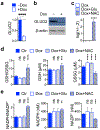Extracellular glutamate and IDH1R132H inhibitor promote glioma growth by boosting redox potential
- PMID: 32020473
- PMCID: PMC7440756
- DOI: 10.1007/s11060-019-03359-w
Extracellular glutamate and IDH1R132H inhibitor promote glioma growth by boosting redox potential
Abstract
Purpose: Somatic mutations of the isocitrate dehydrogenase 1 (IDH1) gene, mostly substituting Arg132 with histidine, are associated with better patient survival, but glioma recurrence and progression are nearly inevitable, resulting in disproportionate morbidity and mortality. Our previous studies demonstrated that in contrast to hemizygous IDH1R132H (loss of wild-type allele), heterozygous IDH1R132H is intrinsically glioma suppressive but its suppression of three-dimensional (3D) growth is negated by extracellular glutamate and reducing equivalent. This study sought to understand the importance of 3D culture in IDH1R132H biology and the underlying mechanism of the glutamate effect.
Methods: RNA sequencing data of IDH1R132H-heterozygous and IDH1R132H-hemizygous glioma cells cultured under two-dimensional (2D) and 3D conditions were subjected to unsupervised hierarchal clustering and gene set enrichment analysis. IDH1R132H-heterozygous and IDH1R132H-hemizygous tumor growth were compared in subcutaneous and intracranial transplantations. Short-hairpin RNA against glutamate dehydrogenase 2 gene (GLUD2) expression was employed to determine the effects of glutamate and the mutant IDH1 inhibitor AGI-5198 on redox potential in IDH1R132H-heterozygous cells.
Results: In contrast to IDH1R132H-heterozygous cells, 3D-cultured but not 2D-cultured IDH1R132H-hemizygous cells were clustered with more malignant gliomas, possessed the glioblastoma mesenchymal signature, and exhibited aggressive tumor growth. Although both extracellular glutamate and AGI-5198 stimulated redox potential for 3D growth of IDH1R132H-heterozygous cells, GLUD2 expression was required for glutamate, but not AGI-5198, stimulation.
Conclusion: 3D culture is more relevant to IDH1R132H glioma biology. The importance of redox homeostasis in IDH1R132H glioma suggests that metabolic pathway(s) can be explored for therapeutic targeting, whereas IDH1R132H inhibitors may have counterproductive consequences in patient treatment.
Keywords: 3D culture; AGI-5198; Glioma; IDH1 mutation; Redox.
Conflict of interest statement
Conflict of interest
The authors declare that they have no conflicts of interest with the contents of this article.
Figures





Similar articles
-
Functional requirement of a wild-type allele for mutant IDH1 to suppress anchorage-independent growth through redox homeostasis.Acta Neuropathol. 2018 Feb;135(2):285-298. doi: 10.1007/s00401-017-1800-0. Epub 2017 Dec 29. Acta Neuropathol. 2018. PMID: 29288440
-
Hominoid-specific enzyme GLUD2 promotes growth of IDH1R132H glioma.Proc Natl Acad Sci U S A. 2014 Sep 30;111(39):14217-22. doi: 10.1073/pnas.1409653111. Epub 2014 Sep 15. Proc Natl Acad Sci U S A. 2014. PMID: 25225364 Free PMC article.
-
Isocitrate dehydrogenase 1-mutated human gliomas depend on lactate and glutamate to alleviate metabolic stress.FASEB J. 2019 Jan;33(1):557-571. doi: 10.1096/fj.201800907RR. Epub 2018 Jul 12. FASEB J. 2019. PMID: 30001166
-
Friend or foe-IDH1 mutations in glioma 10 years on.Carcinogenesis. 2019 Nov 25;40(11):1299-1307. doi: 10.1093/carcin/bgz134. Carcinogenesis. 2019. PMID: 31504231 Free PMC article. Review.
-
Glutamate as chemotactic fuel for diffuse glioma cells: are they glutamate suckers?Biochim Biophys Acta. 2014 Aug;1846(1):66-74. doi: 10.1016/j.bbcan.2014.04.004. Epub 2014 Apr 18. Biochim Biophys Acta. 2014. PMID: 24747768 Review.
Cited by
-
Metabolic plasticity of IDH1-mutant glioma cell lines is responsible for low sensitivity to glutaminase inhibition.Cancer Metab. 2020 Oct 21;8:23. doi: 10.1186/s40170-020-00229-2. eCollection 2020. Cancer Metab. 2020. PMID: 33101674 Free PMC article.
-
Evolutionary Changes in Primate Glutamate Dehydrogenases 1 and 2 Influence the Protein Regulation by Ligands, Targeting and Posttranslational Modifications.Int J Mol Sci. 2024 Apr 14;25(8):4341. doi: 10.3390/ijms25084341. Int J Mol Sci. 2024. PMID: 38673928 Free PMC article. Review.
-
The neural stem-cell marker CD24 is specifically upregulated in IDH-mutant glioma.Transl Oncol. 2020 Oct;13(10):100819. doi: 10.1016/j.tranon.2020.100819. Epub 2020 Jul 1. Transl Oncol. 2020. PMID: 32622311 Free PMC article.
-
Pathways of 4-Hydroxy-2-Nonenal Detoxification in a Human Astrocytoma Cell Line.Antioxidants (Basel). 2020 May 5;9(5):385. doi: 10.3390/antiox9050385. Antioxidants (Basel). 2020. PMID: 32380768 Free PMC article.
-
Lifting the veil on tumor metabolism: A GDH1-focused perspective.iScience. 2025 May 3;28(6):112551. doi: 10.1016/j.isci.2025.112551. eCollection 2025 Jun 20. iScience. 2025. PMID: 40487432 Free PMC article. Review.
References
MeSH terms
Substances
Grants and funding
LinkOut - more resources
Full Text Sources
Medical
Miscellaneous

